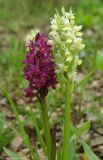Dactylorhiza romana ssp. georgica Taxon details
online plant identification guide
Dactylorhiza romana ssp. georgica
Show section
Images
Russian names
Scientific:
Taxonomy
   |
Dactylorhiza romana ssp. georgica Пальчатокоренник желтоватый |
| division | Magnoliophyta |
| class | Liliopsida |
| ordo | Orchidales |
| familia | Orchidaceae |
| genus | Dactylorhiza |
| species | romana |
| subspecies | georgica |
In original source this name was considered as synonym of Dactylorhiza flavescens
Images
From 1 to 30 are shown (30 of 120 found)
 |
Dactylorhiza romana ssp. georgica Цветущие растения. Краснодарский край, Туапсинский р-н, Главный Кавказский хр., окр. горы Семиглавая, высота 1400 м н.у.м., субальпийский луг. 19.05.2024. |
 |
Dactylorhiza romana ssp. georgica Цветущее растение. Краснодарский край, Туапсинский р-н, Главный Кавказский хр., окр. горы Семиглавая, высота 1400 м н.у.м., в соснах. 19.05.2024. |
 |
Dactylorhiza romana ssp. georgica Цветущее растение. Краснодарский край, м/о г. Новороссийск, вершина 429, остепнённый луг. 10.04.2024. |
 |
Dactylorhiza romana ssp. georgica Верхушка побега с соцветием. Краснодарский край, м/о г. Новороссийск, вершина 429, остепнённый луг. 10.04.2024. |
 |
Dactylorhiza romana ssp. georgica Цветущее растение. Краснодарский край, м/о г. Новороссийск, вершина 429, остепнённый луг. 10.04.2024. |
 |
Dactylorhiza romana ssp. georgica Верхушка побега с соцветием. Краснодарский край, м/о г. Новороссийск, вершина 429, остепнённый луг. 10.04.2024. |
 |
Dactylorhiza romana ssp. georgica Часть соцветия. Дагестан, Кумторкалинский р-н, хр. Нарат-Тюбе, криволесье из дуба и сосны по гребню, ок. 670 м выс., н. у. м. 26 апреля 2023 г. |
 |
Dactylorhiza romana ssp. georgica Соцветие. Краснодарский край, Мостовской р-н, хр. Малые Бамбаки, ≈ 1600 м н.у.м., субальпийский луг. 21.05.2022. |
 |
Dactylorhiza romana ssp. georgica Цветущее растение. Краснодарский край, Туапсинский р-н, Главный Кавказский хр., окр. горы Семиглавая, высота 1400 м н.у.м., субальпийский луг. 27.05.2023. |
 |
Dactylorhiza romana ssp. georgica Цветущее растение. Абхазия, Гагрский р-н, гора Мамдзышха, выс. 1810 м н.у.м., альпийский луг. 15.05.2021. |
 |
Dactylorhiza romana ssp. georgica Соцветие. Абхазия, Гагрский р-н, гора Мамдзышха, выс. 1810 м н.у.м., альпийский луг. 15.05.2021. |
 |
Dactylorhiza romana ssp. georgica Цветущее растение. Абхазия, Гагрский р-н, гора Мамдзышха, выс. 1810 м н.у.м., альпийский луг. 15.05.2021. |
 |
Dactylorhiza romana ssp. georgica Цветущее растение. Абхазия, Гагрский р-н, гора Мамдзышха, выс. 1798 м н.у.м., альпийский луг. 15.05.2021. |
 |
Dactylorhiza romana ssp. georgica Цветущее растение. Абхазия, Гагрский р-н, гора Мамдзышха, выс. 1798 м н.у.м., альпийский луг. 15.05.2021. |
 |
Dactylorhiza romana ssp. georgica Цветущие растения. Дагестан, Табасаранский р-н, окр. с. Татиль, буковый лес. 4 мая 2022 г. |
 |
Dactylorhiza romana ssp. georgica Цветущие растения. Дагестан, Табасаранский р-н, окр. с. Татиль, буковый лес. 4 мая 2022 г. |
 |
Dactylorhiza romana ssp. georgica Соцветие с цветками и завязавшимися плодами. Дагестан, Табасаранский р-н, окр. с. Татиль, буковый лес. 4 мая 2022 г. |
 |
Dactylorhiza romana ssp. georgica Цветущее растение. Дагестан, Табасаранский р-н, окр. с. Татиль, буковый лес. 4 мая 2022 г. |
 |
Dactylorhiza romana ssp. georgica Верхушка соцветия. Дагестан, Табасаранский р-н, окр. с. Татиль, буковый лес. 4 мая 2022 г. |
 |
Dactylorhiza romana ssp. georgica Цветущее растение. Дагестан, Табасаранский р-н, окр. с. Татиль, буковый лес. 4 мая 2022 г. |
 |
Dactylorhiza romana ssp. georgica Верхушка соцветия. Дагестан, Табасаранский р-н, окр. с. Татиль, буковый лес. 4 мая 2022 г. |
 |
Dactylorhiza romana ssp. georgica Цветущее растение. Дагестан, Табасаранский р-н, окр. с. Татиль, буковый лес. 4 мая 2022 г. |
 |
Dactylorhiza romana ssp. georgica Цветок. Дагестан, Табасаранский р-н, окр. с. Татиль, буковый лес. 4 мая 2022 г. |
 |
Dactylorhiza romana ssp. georgica Цветок. Дагестан, Табасаранский р-н, окр. с. Татиль, буковый лес. 4 мая 2022 г. |
Indications in Red Lists (11)
Республика Адыгея (2011) — as Dactylorhiza flavescens
Республика Адыгея (2021) — as Dactylorhiza flavescens
Республика Дагестан (1998) — as Dactylorhiza flavescens
Краснодарский край (2007) — as Dactylorhiza flavescens
Краснодарский край (2017) — as Dactylorhiza flavescens
Ставропольский край (2002) — as Dactylorhiza flavescens
Ставропольский край (2013) — as Dactylorhiza flavescens
Туркменистан (1999) — as Dactylorhiza flavescens
Туркменистан (2011) — as Dactylorhiza flavescens
Туркменистан (2024) — as Dactylorhiza flavescens
Республика Южная Осетия (2017) — as Dactylorhiza flavescens
Web resources
Гербарий (plant.depo.msu.ru)Complain
Сканы гербарных образцов (MW)
Text to cite the page
Dactylorhiza romana ssp. georgica (Klinge) Soó ex Renz & Taubenheim // Плантариум. Растения и лишайники России и сопредельных стран: открытый онлайн атлас и определитель растений. [Электронный ресурс] URL: https://www.plantarium.ru/page/view/item/12625.html (дата обращения: 08.02.2025).
Dactylorhiza romana ssp. georgica (Klinge) Soó ex Renz & Taubenheim // Plantarium. Plants and lichens of Russia and neighboring countries: open online galleries and plant identification guide. URL: https://www.plantarium.ru/lang/en/page/view/item/12625.html (accessed on 8 Feb 2025).
Plants and lichens
Participant
Search
|
|
Feedback | To the top |











